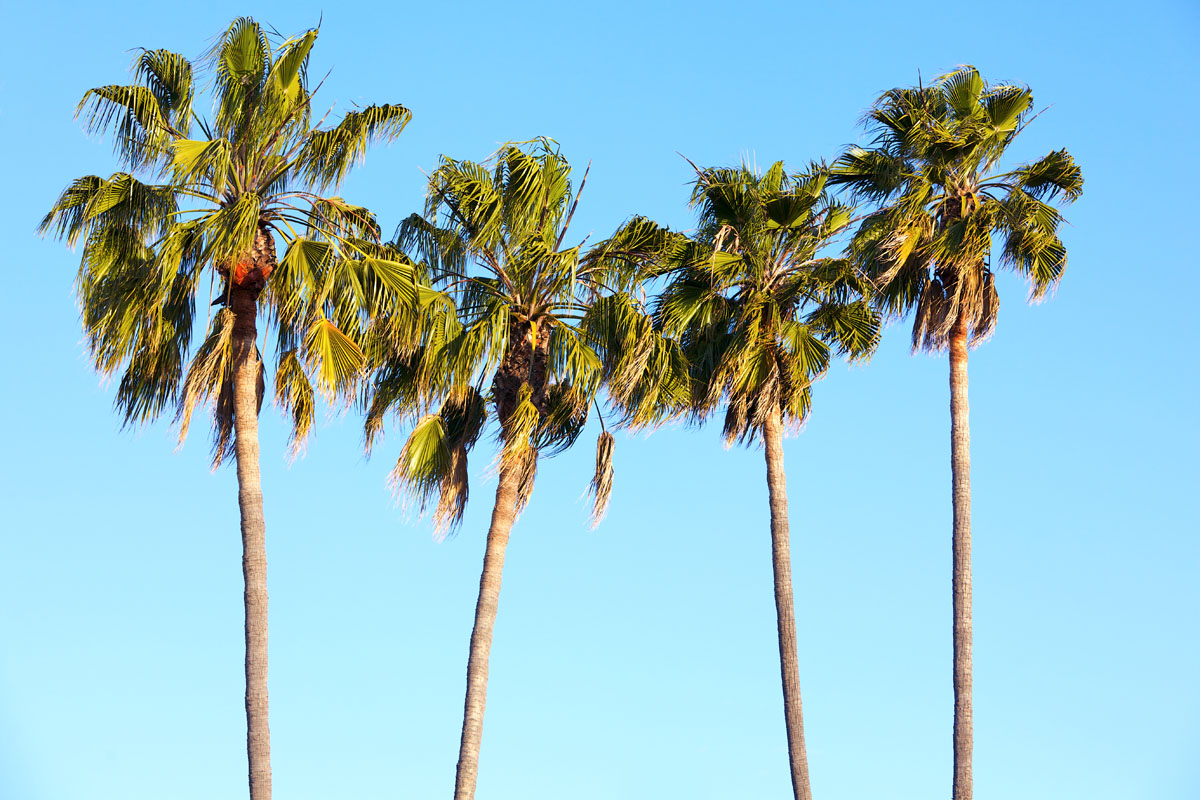Topping a palm tree, which involves cutting off the crown or upper portion of the tree, is generally not recommended and can be harmful to the tree. Unlike some other types of trees, palm trees do not have a traditional branching structure, and their growing points are primarily located at the top, within the crown. Topping a palm tree can have several negative consequences:
- Stress and Damage: Topping a palm tree causes significant stress to the tree, as it removes the entire canopy and growing points. This can lead to shock and injury, making the tree more susceptible to disease and pests.
- Weakened Structure: Palm trees are not designed to regrow in the same way that deciduous trees with branches can. When a palm tree is topped, it may attempt to produce new growth from dormant buds near the cut, but this new growth is often structurally weaker and more prone to breakage.
- Disease and Pests: The exposed cut areas are vulnerable to disease and pest infestations. Insects and fungi can easily enter the tree through the cut surface.
- Aesthetic Issues: Topped palm trees can have an unattractive appearance with irregular regrowth. This can detract from the tree’s natural beauty and symmetry.
- Stunted Growth: Topping can stunt the overall growth of the palm tree, making it less healthy and less able to produce fronds and flowers.
If you need to manage the size of a palm tree, it’s better to consider alternative methods such as pruning or thinning. Proper pruning can remove dead or diseased fronds, improve the tree’s appearance, and maintain its health. However, pruning should be done with care, and it’s often best performed by a professional arborist or tree service to ensure it’s done correctly and safely.
In some cases, when a palm tree is severely damaged, has become a safety hazard, or is in an undesirable location, removal may be the most appropriate option. It’s important to consult with a certified arborist or tree care professional to assess the tree’s condition and determine the best course of action for its care or removal.
What Diseases Affect Palm Trees?
Palm trees can be susceptible to various diseases, which can vary depending on the species and environmental conditions. Some common diseases that affect palm trees include:
- Ganoderma Butt Rot: This fungal disease is one of the most serious and destructive diseases affecting palm trees. It attacks the base of the tree, causing decay and weakening the structural integrity. Infected trees may show symptoms like wilting fronds and a conk (mushroom-like growth) near the base. There is no cure for advanced infections, and the affected trees usually need to be removed.
- Fusarium Wilt: Fusarium wilt is caused by a soil-borne fungus that affects several palm species. It can cause fronds to wilt and die. Prevention is crucial, as there is no cure for infected trees. Choosing disease-resistant palm species and maintaining proper soil health are preventive measures.
- Thielaviopsis Trunk Rot: This fungal disease affects the trunk of the palm tree, leading to rotting and reduced stability. Symptoms include frond wilting, dark streaks on the trunk, and a rotten odor. Affected trees often need to be removed, and fungicides are generally ineffective.
- Lethal Yellowing: Lethal yellowing is a bacterial disease that affects several palm species, especially coconut palms. It causes yellowing and death of the fronds. Regular preventive injections of antibiotics can help control the disease in some cases.
- Palm Leaf Spot Diseases: Various fungal leaf spot diseases, such as Cercospora leaf spot and Pestalotiopsis leaf spot, can affect the fronds of palm trees, causing dark spots, browning, and frond death. These diseases are often managed with fungicides and by removing and disposing of infected fronds.
- Sooty Mold: Sooty mold is a black, powdery fungus that can grow on the honeydew produced by pests like aphids, scales, and mealybugs. It can cover the fronds and reduce photosynthesis. Controlling the underlying pest problem is key to preventing sooty mold.
- Pink Rot: Pink rot is a fungal disease that affects the roots and bases of palm trees, causing rot and wilting of fronds. Good drainage and avoiding overwatering can help prevent this disease.
- Texas Phoenix Palm Decline (TPPD): This bacterial disease primarily affects Phoenix species of palm trees, including date palms. Symptoms include wilting, yellowing, and death of fronds. The disease is spread by an insect vector, and management strategies often involve controlling the vector and removing infected trees.
Preventing palm tree diseases is crucial for their long-term health. This includes selecting disease-resistant species, maintaining proper soil and environmental conditions, practicing good sanitation (removing and disposing of dead fronds and affected plant material), and promptly addressing any pest problems. Regular inspections by a certified arborist or plant health care professional can help detect and address diseases early, increasing the chances of effective treatment and prevention.
Can I Cut A Palm Tree In Half?
If you cut a palm tree in half, it will not grow back as a whole tree. Palms are monocotyledonous plants, which means they do not possess the ability to regenerate from the top portion of the tree if it’s cut off. Unlike many other types of trees, palms do not have branches or secondary growth points (meristems) that can develop into new trunks or stems.
However, some palm species may be able to produce new growth from the lower part of the trunk or the base of the tree if the growing point (known as the apical meristem) is still intact. This new growth is known as “suckers” or “offshoots.” Whether a palm tree will produce suckers and survive after being cut in half depends on the specific palm species, the health of the tree, and the severity of the cut.
In many cases, severe cutting or damage to a palm tree can be detrimental to its overall health and survival. It’s generally advisable to avoid cutting palm trees unless it is necessary for safety reasons or as part of a planned pruning process. If you need to trim or remove a palm tree, it’s best to consult with a professional arborist or a tree care specialist who can assess the tree’s condition and provide guidance on the appropriate course of action.
When it comes to severing off the growing tip or better know as the ‘crownshaft’ of any Single-Truck palm species, will in short effectively terminates the life of the palm tree. The trunk will not be able to sprout a new growing tip in place of the old missing crownshaft, and without the extra foliage to synthesize the incoming light, the palm soon grows weak and the entire trunk system starts to rot. If you do end up having to cut off the top of any single-trunked palms or if any sort of damage happens to it, the next initial move would be to remove the remainder of the palm tree trunk and root system and completely restart with a brand new tree.
Some examples of single-trunk palms include the Mexican fan Palm, Royal palm, Christmas Palm, and the Cabbage palm. These are all great options to choose from when choosing which Single-Trunk palm to birth.
Clustering Palms
Clustering palms are incredibly unique and grow multiple trunk stems, this means you can shave away some trunks without ending the plants’ life. In any case if the individual palm trunk is removed solely, it will not be able to heal itself. Even if you where to make the decision to cut off the trunks on the palm near the root level, suckering explodes from this root level and will eventually sprout and develop into new healthy palm tree trunks. The suckering process and rejuvenation will only happen in the case of a healthy clustering palm. On the other hand, diseased on distressed palms may not create new suckers and may eventually end up dying.
Palm Tree Trunk Wounds
Naturally Palm trees lack cambium – which is a layer of tissue behind the tree bark that creates the growth rings in the tree. Any wounds inflicted to the trunk of a palm tree cannot repair itself meaning these wounds will remain with the palm for the rest of its life. The wounds can and most likely will become dry and brittle unless weather conditions are full of rain or high humidity which can prevent the wounds from drying out. If it is not obvious enough, Insects and fungal infections can penetrate the palm and cause massive damage to the plant’s articular system.
Pruning
When it comes to the pruning aspect of the palm tree there are crucial factors that come into play during this process. One being that it is important to never sever the downshaft on a palm. Another tip is to remove just the right amount of fronds, or you may just stunt your palms growth, and an obvious one– never introduce any sort of diseases to the plants. In short palm pruning can be hard to manage and is better left to the professionals. If you do decide to proceed with pruning the palm yourself, go ahead and remove only the broken fronds that are entirely dead with no color left to them. Also removing flowers and/or fruit is acceptable and gives the palm more energy to spend time creating new leaves.
Palm Tree Assessment in Phoenix, Tempe, & More
If you think your palm trees are in need of care Arbor Care can help! We can assist you in getting down to your palm trees health and can provide helpful hints to keep your palm trees happy and healthy. Contact Arbor Care at 480-797-5566 today to schedule your palm tree assessment.




